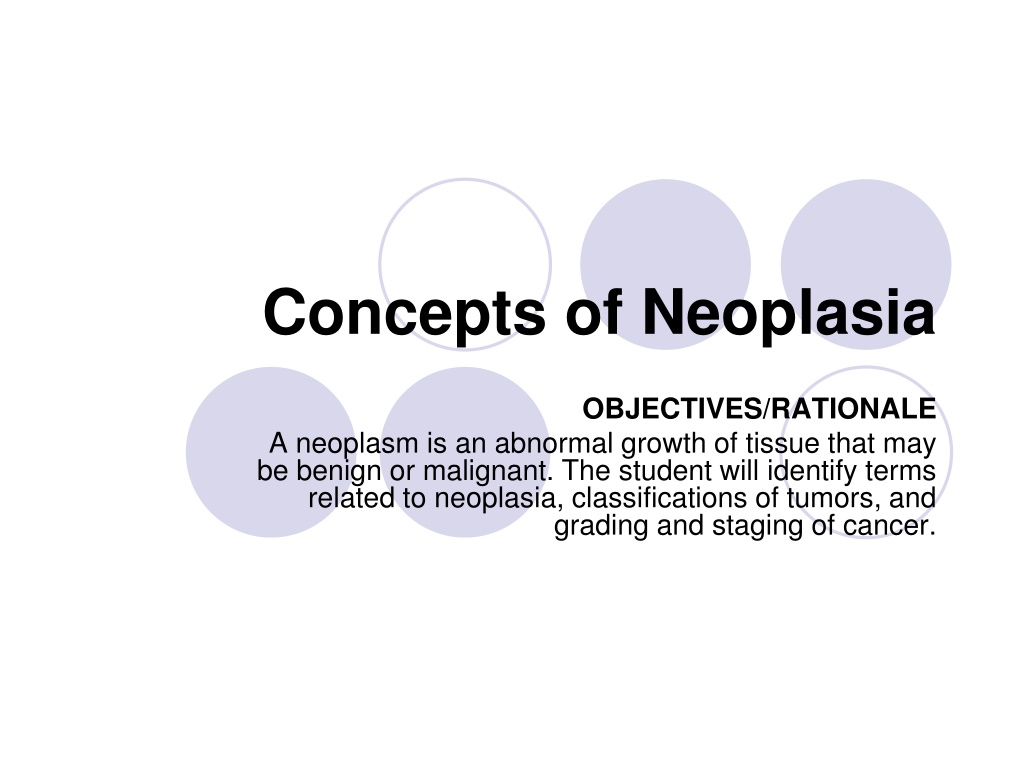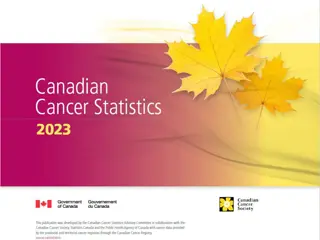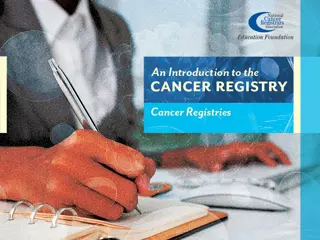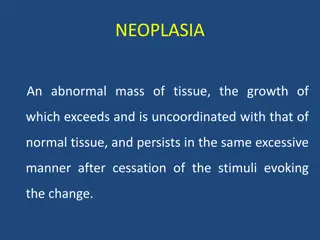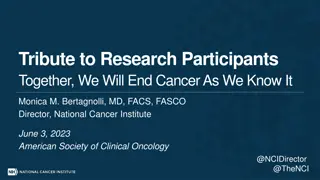Understanding Neoplasia and Cancer: Key Concepts and Biological Aspects
Neoplasia encompasses abnormal tissue growth that can be benign or malignant. This article explores neoplastic terms, tumor classifications, cancer staging, and genetic factors in cancer development. Gain insights into the characteristics of benign tumors, the biology of cancer including carcinogenesis, mutations, oncogenes, tumor suppressor genes, and DNA repair mechanisms. Stay informed about the global impact of cancer and the importance of early detection and treatment.
Download Presentation

Please find below an Image/Link to download the presentation.
The content on the website is provided AS IS for your information and personal use only. It may not be sold, licensed, or shared on other websites without obtaining consent from the author. Download presentation by click this link. If you encounter any issues during the download, it is possible that the publisher has removed the file from their server.
E N D
Presentation Transcript
Concepts of Neoplasia OBJECTIVES/RATIONALE A neoplasm is an abnormal growth of tissue that may be benign or malignant. The student will identify terms related to neoplasia, classifications of tumors, and grading and staging of cancer.
Cancer Statistics Cancer is the leading cause of death worldwide and afflicts two of every three families. Deaths from cancer in the world are projected to continue to rise with an estimated 9 million deaths projected in 2015 and 11.4 million deaths in 2030, according to the World Health Organization. In the United States, approximately one of every two men and one of every three women will be diagnosed with an invasive cancer in their lifetime.
I. General Aspects of Neoplasia A. Cells a. Many cells of the body are constantly undergoing reproduction and maturation b. All cell lines go through the process of differentiation (primitive non-specialized cell that matures into a specific cell type based on function it will perform) c. A cell that is non-differentiated is one that has remained in a rudimentary state (or regressed back to earlier stage) - Cancer (Ca) cells are less differentiated (more primitive) or completely non-differentiated
Neoplasia Uncontrolled growth of cells Neoplasm or tumor: a mass of cells that grow more rapidly than normal cells Benign - noncancerous Malignant - consists of rapidly dividing cells that accumulate uncontrollably and invade normal tissue and have the ability to metastasize or generate independent tumors at distant sites
Characteristics of Benign Tumors Classified according to tissue of origin Encapsulated with clearly defined edges Do not metastasize or recur following surgery Differentiated; resembles the tissue from which it grew
Biology of Cancer Carcinogenesis- development of cancer and is multistep process that involves a complex sequences of genetic mutations Mutation- a change in the biochemistry of a gene resulting in the production of abnormal cells Oncogene- a gene that when mutated or expressed at abnormally high levels contributes to converting normal cell into a cancer cell; normally they encode proteins that regulates cell growth, differentiation, and apoptosis Tumor supressor genes- (TSG) the protein of a TSG is responsible for cell cycle control, checkpoint control, cell signaling, promotion of apoptosis, and DNA repair; inactivation of TSG s causes genetic instability DNA repair genes- (caretaker genes) responsible for the repair of errors in normal DNA replication
Etiolology of Cancer Epidemiology Endogenous Genetics- age, race, heredity, hormones, and immunity Environmental Tobacco Industrial chemicals and radiations Diet Alcohol Chronic infections Medicinal carcinogens
Click here to view a video on the topic of the genetics of cancer. Return to Directory
II. Classification of Neoplasia by Tissue Origin Epithelial Tissue malignant growths arising from this tissue are called carcinomas - Epithelial tissue includes: internal organs, linings of body cavities, and glands Connective Tissue malignant growths arising from this tissue are called sarcomas - Connective tissue includes: bone, muscle, and blood Special Tissue Malignancies - Glial Tissue malignant growths arising from connective tissue of brain and nervous system are called gliomas Benign Tumors Are Named On Basis of Involved Tissue - Name of tissue involved + suffix oma (as opposed to carcinoma and sarcoma); ex. Osteoma Mixed Cancer epithelial and connective tissue Lymphoma Lymphoid tissue Leukemia white blood cells Melanoma melanin
Classification of Neoplasia Tissue Type Benign Malignant EPITHELIAL TISSUE: Tissue Type Gland Papilloma Adenoma Papilloma Adenocarcinoma Papillocarcinoma CONNECTINE TISSUE: Tissue type Bone Cartilage Fat Osteoma Chondroma Lipoma Octeosarcoma Chondrosarcoma Liposarcoma SPECIAL TISSUE: Glia nerve tissue Glioma
III. Uncontrolled Growth of Cancer Cells A. cancer cells grow without the stop controls that characterize normal cell growth 1. there is rapid cell division and reproduction (mitoses) 2. at certain stage of development, cancer cells fail to mature 3. when squamous epithelial cancer has not moved past the basement membrane, it is temporarily contained and said to be in situ - this can be seen in early lesions of the cervix, mouth, and larynx 4. cancers break through the underlying tissue and metastasize
III. Uncontrolled Growth of Cancer Cells (Continued) B. cancer cells can metastasize in three ways: 1. cancer can shed cells that can circulate into the blood and lymphatic systems 2. by accidental transplantation during invasive (surgical) procedures 3. progressive, invasive growth that spreads to adjacent organs
IV. Etiology of Cancer (Proven and Suspected) Carcinogenesis has no single cause.
Non-specific Warning Signs of Cancer Changes in bowel or bladder habits A sore that does not heal Unusual bleeding or discharge Thickening or lump in the breast or any other part of the body Indigestion or difficulty swallowing An obvious change in a wart or mole A nagging cough or hoarseness (American Cancer Society)
IV. Etiology of Cancer (Proven and Suspected) B. Carcinogenesis may result from complex interactions between viruses, physical and chemical carcinogens, and genetic, dietary, immunologic, and hormonal factors. a. The Virus Aspect animal research has shown that viruses can transform cells 1. Epstein-Barr virus that causes infectious mononucleosis is associated with Burkett s lymphoma and nasopharyngeal Ca. 2. Types of human papilloma virus are linked to cervical Ca. 3. Hepatitis B virus can cause liver Ca. 4. Human T-cell lymphotropic virus is suspected of causing adult T-cell leukemia
IV. Etiology of Cancer (Proven and Suspected) b. Exposure & Environmental Chemicals Factors relationship between excessive exposure to sun s UV rays and skin Ca is well established; substances in the environment can cause cancer by damaging DNA in cells. 1. UV exposure and sunburn linked to melanoma 2. radiation exposure suspected to provoke tumor development and leukemia 3. also contributing to the exposure aspect are: individual s tissue type, age, hormonal status, health status 4. chemicals from tobacco contain common carcinogens and are related to cancers such as: lung, pancreatic, kidney, bladder, and esophageal Ca) 5. asbestos and airborne hydrocarbons are related to lung Ca
IV. Etiology of Cancer (Proven and Suspected) c. Specific Dietary Suspects some types of foods, additives and preparation are considered cancer risks. 1. High-protein and high-fat diets 2. Food additives such as nitrates 3. Charbroiling
IV. Etiology of Cancer (Proven and Suspected) d. Familial Tendencies: The Genetic Factor i. Some cancers have a familial link and share the following characteristics: 1. early onset 2. increased incidence of bilateral cancer in paired organs (breasts, adrenal glands, kidneys) 3. increased incidence of multiple primary cancers in nonpaired organs 4. unique tumor site combinations 5. two or more family members in same generation with same cancer
IV. Etiology of Cancer (Proven and Suspected) e. The Hormone Factor 1. The role hormones play in cancer is controversial 2. excessive hormone use (estrogen) has shown increased risk for certain types of cancer (ovarian, breast)
V. Grading and Staging of Malignant Neoplasia A. Classification process that is helpful in determining prognosis and treatment a. Grading a histologic method used by pathologists when they examine tissue or cell specimens 1. Looking for differentiation 2. Severity of malignancy can be assessed by degree of dysplasia or anaplasia present (remember anaplastic cells have de-differentiated or regressed from normal mature form) 3. Growth rate can be loosely determined by number of mitotic cells present an increase in numbers means that cells are reproducing faster
V. Grading and Staging of Malignant Neoplasia b. Recognized grades of malignancy: 1. Grade I cells are well differentiated (closely resemble tissue of origin), with little mitoses. Prognosis is good. 2. Grade II cells are moderately differentiated (some structural similarity to parent tissue), with moderate mitoses. Prognosis is fair. 3. Grade III Cells are poorly differentiated (little resemblance to their origin), with many mitoses. Prognosis is fair to poor. 4. Grade IV Cells are de-differentiated (bizarre and primitive with unrecognizable origins), with many mitoses. Prognosis is poor.
V. Grading and Staging of Malignant Neoplasia c. Staging a classification based on clinical findings by the physician (often oncologist) 1. stage relates to degree of spread (whereas grade relates to malignancy) 2. staging is based on size of primary tumor and amount of metastasis or secondary tumors
V. Grading and Staging of Malignant Neoplasia d. Rules of Staging Follow TNM protocol: 1. T refers to tumor size (1 to 4) 2. N refers to numbers of lymph nodes affected (local invasion) 3. M means the extent of metastasis ii. Staging usually has a better correlation with prognosis.
Cancer Treatment Prevention- pg 75 Chemoprevention Screening Chemotherapy Radiation therapy Surgery
Table 4-6: American Cancer Society Recommendations for Early Detection of Cancer in Asymptomatic People
